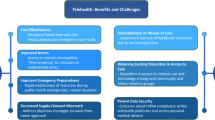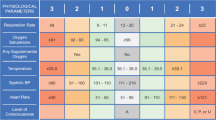Abstract
Background
Telemedicine is increasingly being used in acute stroke care. Some of the first studies and network projects are already applying remote audiovisual communication for patient evaluation. Formerly the telephone was the method of choice to contact experts for case discussion. We compared remote video-examination and telephone consultation in acute stroke care.
Methods
Two district hospitals were linked to stroke centers in Northern Bavaria. Patients with symptoms suggestive of an acute stroke were included. Remote video examination (RVE) was provided by live audiovisual communication and access to brain images; telephone consultation (TC) was done via standard telephone using a structured interview. There was a weekly rotation of the two methods. Demographic data and other data concerning process and quality of care as well as outcome 10 days after stroke were recorded and compared between the two groups.
Results
Within the study period 151 consultations were made in acute stroke patients (mean age 66.8 years). 77 patients were seen by RVE and 74 by TC. Total examination times were 49.8 min for RVE and 27.2 min for TC (p < 0.01). Patients were more frequently transferred to the stroke center after TC consultation (9.1 % vs. 14.9 %, p < 0.05) and had a higher mortality 10 days after stroke (6.8 % vs. 1.3 %, p < 0.05). Diagnosis made by TC had to be corrected more frequently (17.6 % vs. 7.1 %; p < 0.05).
Conclusions
Creating a network improves stroke care by establishing cooperation between hospitals. Telephone consultation could be a simple method of telemedicine to support cooperation as it is easy and widely available. However, outcome parameters like mortality indicate that remote video examination is superior to TC. Therefore, full-scale audiovisual communication is recommended for remote consultation in acute stroke care.
Similar content being viewed by others
References
Audebert HJ, Kukla C, Clarmann von Clarnau S, et al. (2005) Telemedicine for safe and extended use of thrombolysis in stroke: the Telemedic Pilot Project for Integrative Stroke Care (TEMPiS) in Bavaria. Stroke 36:287–291
Audebert HJ, Kukla C, Vatankhah B, Gotzler B, Schenkel J, Hofer S, Furst A, Haberl RL (2006) Comparison of tissue plasminogen activator administration management between Telestroke Network hospitals and academic stroke centers: the Telemedical Pilot Project for Integrative Stroke Care in Bavaria/Germany. Stroke 37:1822–1827
Audebert HJ, Schenkel J, Heuschmann PU, Bogdahn U, Haberl RL; Telemedic Pilot Project for Integrative Stroke Care Group (2006) Effects of the implementation of a telemedical stroke network: the Telemedic Pilot Project for Integrative Stroke Care (TEMPiS) in Bavaria, Germany. Lancet Neurol 5:742–748
Berger K, Weltermann B, Kolominsky-Rabas P, Meves S, Heuschmann P, Bohner J, Neundorfer B, Hense HW, Buttner T (1999) The reliability of stroke scales. The german version of NIHSS, ESS and Ranking scales. Fortschr Neurol Psychiatr 67:81–93
Handschu R, Littmann R, Reulbach U, Gaul C, Heckmann JG, Neundorfer B, Scibor M (2003) Telemedicine in emergency evaluation of acute stroke: interrater agreement in remote video examination with a novel multimedia system. Stroke 34:2842–2846
Heuschmann PU, Kolominsky-Rabas PL, Roether J, Misselwitz B, Lowitzsch K, Heidrich J, Hermanek P, Leffmann C, Sitzer M, Biegler M, Buecker-Nott HJ, Berger K (2004) German Stroke Registers Study Group. Predictors of in-hospital mortality and attributable risks of death after ischemic stroke: the German Stroke Registers Study Group. Arch Intern Med 164:1761–1768
La Monte M, Bahout M, Hu P, Pathan M, Yarbrough K, Gunawardane R, Crarey P, Page W (2003) Telemedicine for acute stroke. Triumphs and pitfalls. Stroke 34:725–728
Levine SR, Gorman M (1999) “Telestroke”: the application of telemedicine for stroke. Stroke 30:464–469
Meyer BC, Lyden PD, Al-Khoury L, Cheng Y, Raman R, Fellman R, Beer J, Rao R, Zivin JA (2005) Prospective reliability of the STRokE DOC wireless/site independent telemedicine system. Neurology 64:1058–1060
Pfefferkorn T, Liebetrau M, Müllner A, Bender A, Hamann GF (2005) Increasing use of intravenous rt-PA does not affect safety in acute stroke. J Neurol 252:1500–1503
Roquer J, Ois A, Rodríguez Campello A, Gomis M, Munteis E, Jiménez Conde J, Martínez-Rodríguez JE (2007) Clustering of vascular risk factors and inhospital death after acute ischemic stroke. J Neurol 254:1636–1641
Shafqat S, Kvedar CJ, Guanci MM, Chang EC, Schwamm LH (1999) Role for Telemedicine in Acute Stroke: Feasibility and Reliability of Remote Administration of the NIH Stroke Scale. Stroke 30:2141–214
Wang S, Lee SB, Pardue C, Ramsingh D, Waller J, Gross H, Nichols FT 3rd, Hess DC, Adams RJ (2003) Remote evaluation of acute ischemic stroke: reliability of National Institutes of Health Stroke Scale via telestroke. Stroke 34:e188–e191
Wiborg A, Widder B, Riepe MW, Krauß M, Huber R, Schmitz B (2000) Contribution of telemedicine to global stroke care in rural areas. Akt Neurol 27:119–124
Wiborg A, Widder B (2003) Teleneurology to improve stroke care in ruralareas: the Telemedicine in Stroke in Swabia (TESS) Project. Stroke 34:2951–2956
Wong HT, Poon WS, Jacobs P, Goh KY, Leung CH, Lau FL, Kwok S, Ng S, Chow L (2006) The comparative impact of video consultation on emergency neurosurgical referrals. Neurosurgery 59:607–613
Author information
Authors and Affiliations
Consortia
Corresponding author
Rights and permissions
About this article
Cite this article
Handschu, R., Scibor, M., Willaczek, B. et al. Telemedicine in acute stroke. J Neurol 255, 1792–1797 (2008). https://doi.org/10.1007/s00415-008-0066-9
Received:
Revised:
Accepted:
Published:
Issue Date:
DOI: https://doi.org/10.1007/s00415-008-0066-9




